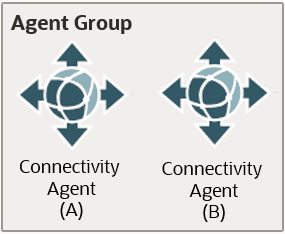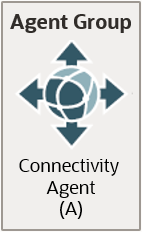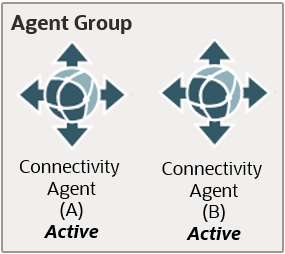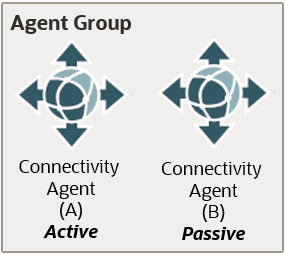Plan the Connectivity Agent Setup
Use the connectivity agent to configure access to resources residing in an on-premises network. When planning the agent setup, determine the number of agent groups to create, the number of connectivity agents in each agent group, and the number of active agents in each group.
To learn more about the connectivity agent, see About Connecting to On-Premises Applications.
| Decision | More information |
|---|---|
|
If you are using the connectivity agent, you must create at least one agent group. |
|
|
You can associate either one or two connectivity agents with each agent group. |
|
|
In each agent group, either one or two agents can be active at a time. |
Number of Agent Groups
When planning the number of agent groups to create, keep in mind several points.
-
You can associate up to two connectivity agents per agent group.
-
You can associate each connectivity agent with only one agent group.
-
You can create up to five agent groups per Oracle Integration service instance.
For example, one service instance could have two agent groups, one with two associated agents, and one with one associated agent.
Some organizations create separate agent groups for each line of business.
-
If you have multiple Oracle Integration service instances, each service instance requires its own agent groups and connectivity agents.
Number of Connectivity Agents in an Agent Group
You can associate one or two connectivity agents with each agent group. The number of connectivity agents to associate with an agent group depends upon your requirements for throughput and resiliency.
| Setup | Why choose this configuration? |
|---|---|
|
Two agents in an agent group (recommended)
|
If you opt for this configuration, you must also choose whether both agents are active at one time. See Number of Active Connectivity Agents. |
|
One agent in an agent group (not recommended for production environments)
|
This configuration introduces risk. A single connectivity agent creates a single point of failure. However, under the following circumstances, you might decide that this risk is acceptable:
For instance, you might opt for a single connectivity agent for a development environment while installing multiple connectivity agents in a production environment. |
You can also mix and match. For instance, associate two connectivity agents with one agent group, and associate a different connectivity agent with a different agent group.
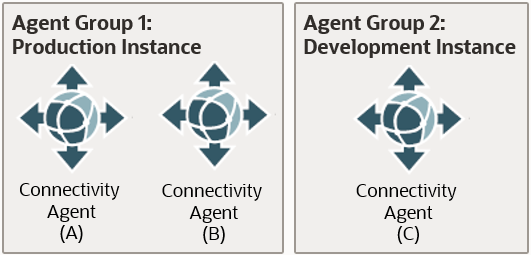
Number of Active Connectivity Agents
When you create an agent group that holds two connectivity agents, you must specify whether one or both of its connectivity agents are active at a time using the Use only one agent at a time setting.
| Setting | Description | Performance impact |
|---|---|---|
|
Use only one agent at a time is not enabled |
Both agents remain active at all times, sharing incoming requests and polling responsibilities.
|
This setup can result in improved performance when compared to agent groups in which Use only one agent at a time is enabled. |
|
Use only one agent at a time is enabled |
The first connectivity agent that you install or start is identified as the active agent. This agent handles all incoming requests and polling responsibilities. For example, a File Adapter polls for files in a specific directory. The second agent that you install or start is identified as the passive agent. This agent doesn't handle any incoming requests or polling responsibilities. Instead, it runs in standby mode, ready to take over if the primary agent fails. If the active agent fails, the passive agent becomes active and handles all incoming requests and polling responsibilities. This agent remains active even after the initially active agent recovers from failure. The recovered agent is now passive and remains in standby mode.
|
This setup can result in lower performance when compared to agent groups in which Use only one agent at a time is not enabled. |
Again, you can create multiple agent groups with different active settings to meet your requirements.

Adapter-Specific Guidance
Several adapters provide an optimized experience when an agent group has only one active agent at a time. Additionally, one adapter requires only one active agent at a time.
| Adapter | Guidance |
|---|---|
|
File Adapter and FTP Adapter |
Required setup for all service instances: Enable Use only one agent at a time. Resiliency during agent failure is improved. These adapters can also work with a connectivity agent that is the only agent in an agent group.
See File Adapter Capabilities in Using the File Adapter with Oracle Integration 3 and FTP Adapter Capabilities in Using the FTP Adapter with Oracle Integration 3. |
|
MLLP Adapter |
Required setup for all service instances: Enable Use only one agent at a time. This adapter can also work with a connectivity agent that is the only agent in an agent group.
The MLLP Adapter allows only one connectivity agent to be active at a time. Therefore, connections that are based on the MLLP Adapter must use an agent group that has enabled this setting, identifiable by the Singleton label. |
|
All other adapters |
Preferred setup for all production service instances: Leave Use only one agent at a time disabled.
|
